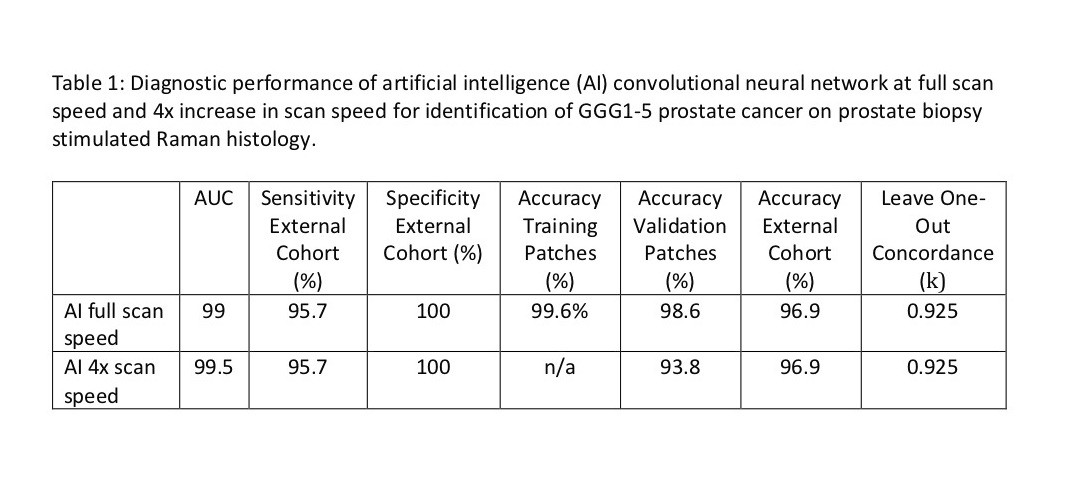Back
Introduction: There is a delay between prostate biopsy and pathologic diagnosis; this delay has limited the use pathologic feedback during the diagnosis and treatment of prostate cancer (PCa). Stimulated Raman histology (SRH) is a novel microscopic technique allowing real time, label-free, high-resolution microscopic images of unprocessed, un-sectioned tissue. We hypothesized that an artificial intelligence convolutional neural network (CNN) could rapidly interpret prostate biopsy SRH.
Methods: Prostate biopsies were prospectively taken ex-vivo from prostatectomy specimens and scanned in a SRH microscope at 20 microns depth using two Raman shifts: 2845cm-1 and 2930cm-1, to create SRH images. The cores were then processed and H&E-stained as per normal pathologic protocols and used for ground truth pathologic assessment. 303 ex-vivo prostate biopsies taken from 100 radical prostatectomy specimens were used to train the SRH Inception-ResNet-v2 CNN. With a two-sided alpha level of 5%, it was calculated 32 biopsies would provide 90% power to detect a difference in concordance kappa when testing the CNN. Concordance and diagnostic accuracy of the CNN were tested on training and validation patches, and the 32 leave-one out prostate biopsies from 23 radical prostatectomy specimens.
Results: The CNN showed a 99.6% weighted accuracy on the training patches and 98.6% when tested on the validation set. The CNN also showed very good kappa concordance (k=0.925, p<0.001) when classifying the 32 prostate biopsies as benign or malignant, giving a diagnostic accuracy of 96.9%, with a scan time of 2-2.75 minutes, Table 1. Additionally, if a region containing PCa was first scanned with SRH, the AI could identify PCa in ~1 minute.
Conclusions: Artificial intelligence applied to SRH can rapidly classify fresh, unprocessed, unstained prostate biopsies as benign or malignant. SOURCE OF
Funding: NIH UL1TR001145

Podium Session
Session: PD38: Prostate Cancer: Detection & Screening IV
PD38-07: Stimulated Raman Histology Interpretation By Artificial Intelligence Can Provide Real-Time Pathologic Feedback of Prostate Biopsies
Sunday, April 30, 2023
4:30 PM – 4:40 PM CST
Location: S502
- MM
Miles Mannas, MD,MSc
Assistant Professor
University of British Columbia
Podium Presenter(s)
Introduction: There is a delay between prostate biopsy and pathologic diagnosis; this delay has limited the use pathologic feedback during the diagnosis and treatment of prostate cancer (PCa). Stimulated Raman histology (SRH) is a novel microscopic technique allowing real time, label-free, high-resolution microscopic images of unprocessed, un-sectioned tissue. We hypothesized that an artificial intelligence convolutional neural network (CNN) could rapidly interpret prostate biopsy SRH.
Methods: Prostate biopsies were prospectively taken ex-vivo from prostatectomy specimens and scanned in a SRH microscope at 20 microns depth using two Raman shifts: 2845cm-1 and 2930cm-1, to create SRH images. The cores were then processed and H&E-stained as per normal pathologic protocols and used for ground truth pathologic assessment. 303 ex-vivo prostate biopsies taken from 100 radical prostatectomy specimens were used to train the SRH Inception-ResNet-v2 CNN. With a two-sided alpha level of 5%, it was calculated 32 biopsies would provide 90% power to detect a difference in concordance kappa when testing the CNN. Concordance and diagnostic accuracy of the CNN were tested on training and validation patches, and the 32 leave-one out prostate biopsies from 23 radical prostatectomy specimens.
Results: The CNN showed a 99.6% weighted accuracy on the training patches and 98.6% when tested on the validation set. The CNN also showed very good kappa concordance (k=0.925, p<0.001) when classifying the 32 prostate biopsies as benign or malignant, giving a diagnostic accuracy of 96.9%, with a scan time of 2-2.75 minutes, Table 1. Additionally, if a region containing PCa was first scanned with SRH, the AI could identify PCa in ~1 minute.
Conclusions: Artificial intelligence applied to SRH can rapidly classify fresh, unprocessed, unstained prostate biopsies as benign or malignant. SOURCE OF
Funding: NIH UL1TR001145

